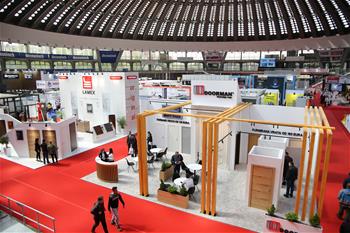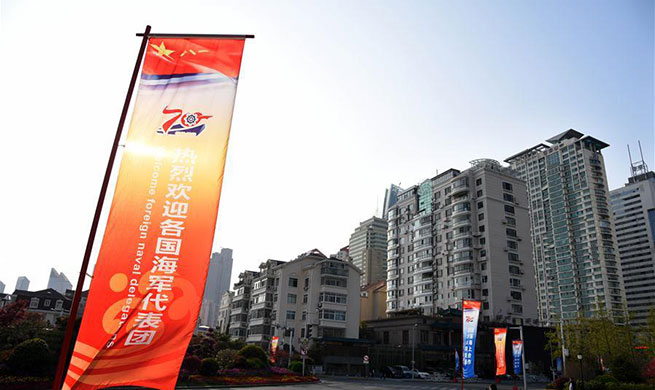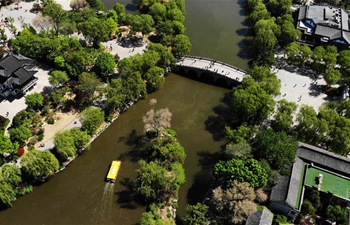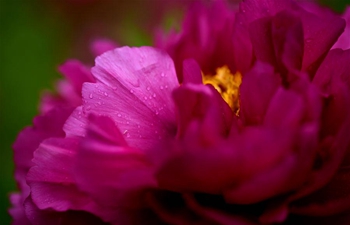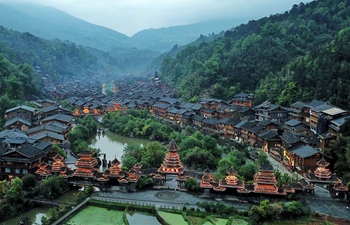CHENGDU, April 18 (Xinhua) -- In a lantern-making factory in the city of Zigong in southwest China's Sichuan Province, Zhou Xian introduces pieces of wires interwoven into a human figure.
"This is the framework of a color lantern based on the image of a Terracotta warrior," says Zhou, vice president of Lantern Group, the biggest lantern-making company in Zigong.
Zhou adjusts the bending parts of the wires frame, the face and armor of the soldier, and after adding colorful silk on the wires, a warrior-shaped lantern will be completed.
"This is a quite demanding process, and if the wires are not welded properly, once the light is on, you will see the defects from the outside," Zhou said.
In Zigong, making colorful lanterns is a big industry, generating an annual revenue of 5 billion yuan (747 million U.S. dollars). The lanterns are so popular that they have even caught the attention of foreigners, with the lanterns on display in the United States, Lithuania and France.
Zigong lanterns have been displayed in more than 500 cities of 74 countries and regions, attracting more than 400 million viewers, according to official figures
"We hope to further expand the markets overseas in the future," Zhou said.
The lantern-making tradition goes way back. During the Tang Dynasty (618-907), locals in Zigong loved lighting oil candles to pray for health and prosperity during the first full-moon of the lunar calendar, or the "Lantern Festival" as it is known today.
As the handicraft art evolved, simple oil candles were replaced by more complicated lanterns. Craftsmen used bamboo shoots and silk to create lanterns in the shape of shining palaces, fairies and giant dragons.
But the most significant change came within the last century. During the planned economy period after the new China was founded, the government in Zigong called on factories, schools, hospitals and companies to "contribute to the annual lantern shows."
People from different walks of life used the materials they were most familiar with and managed to create a host of novel lanterns. Things like silkworm cocoons, glass medicine bottles, teacups and even flashlight shades were introduced into the making of lanterns.
The unique lanterns in Zigong gradually became distinctive from other parts of China, and their reputation even expanded to other parts of the world.
These days, making a Zigong lantern involves many craftsmen, including art designers, bench workers, mechanics, electricians and paperhanging workers. The complete process can hardly be found in other places in China.
Another important craftsmanship is about binding. At a lantern show held in early 2019 in Zigong, workers bound plates, spoons, teacups and goblets into lanterns in the shape of chime bells. The lanterns were 30 meters tall and weighed several tonnes.
"Western viewers really love handmade work instead of industrialized stuff," said Liu Cheng, also vice president of Lantern Group. "Our company experienced explosive growth thanks to our performance in the European markets."
Liu said that last year lantern shows in overseas markets brought more than 200 million yuan in revenue for the company.
With the fast development of China's economy, more and more people are interested in the Chinese culture, and many are intrigued by the traditional lanterns, said Luo Rui, with Haitian Lantern, also a lantern-maker in Zigong.
At the end of last year, the company entered the markets in Eastern Europe for the first time, with lantern shows held in Lithuania, Estonia and Ukraine.
"Many people in Lithuania came to see the 40-meter-long dragon lantern we created," Luo said. "The dragon could 'move' its head, and smoke as high as six meters billowed out of its mouth."
The company was even invited to attend the China-Central and Eastern European Countries Economic and Trade Forum.
"Colorful lanterns have lit up the global stage," Luo said. "I believe the future for traditional lanterns will be glittering."







